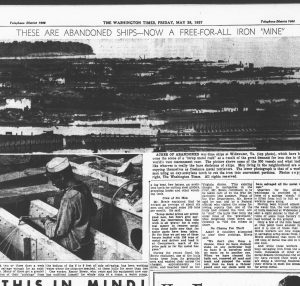Mallows Bay
“The Ghost Fleet” at Mallows Bay was written by Stafford County Historical Society member, Beth Daly.
In April 1917, Congress authorized funds (about a billion dollars, equivalent to $13 billion today) for the Emergency Fleet Corporation; it would be “a wooden bridge of ships” to Europe. The keel of the first ship, the “Aberdeen,” was laid in Aberdeen, Washington, in September 1918. The ships were wooden, as steel was not available, and steam-powered by coal – 19th century technology. The wood was green, unseasoned, and unsuitable for shipbuilding.
When World War I ended the government needed to figure out what to do with all these ships (they were still being built at a rapid pace in 40 shipyards). They could be used for post-War oceanic transport, except they leaked and were not seaworthy. Quickly the government decided to dispose of the ships and sold them to the Western Marine and Salvage Corporation for $750,000. WMSC set about dismantling the ships. First, they took the ships to Alexandria, Virginia, where they made an oily mess, resulting in the fiery destruction of several piers. They were chased out of Alexandria down the Potomac River to Quantico. About ten ships, including the “Aberdeen” were dismantled there. Local fishermen complained about the pollution. People in the Widewater area helped themselves to furniture, hardware, lanterns, anything they could carry. Some families still have souvenirs from the ships.
The late D.P. Newton said that there is a house near Grafton Village built from timbers of one of the ships. The ships were towed across the Potomac to Mallows Bay, Maryland. The area had been a dumping ground for abandoned ships, even a Revolutionary War ship, for over a hundred years. This was a large fleet, between 100 and 200 ships (depending upon the reference). The ships continued to leach pollutants. At sunrise one morning in the 1920s, the ships were burned to their waterlines. Stripping the hulls of anything that could be recycled, primarily metal, became a cottage industry for locals. It is said Japan was the best market for the metal. At the beginning of World War II, Bethlehem Steel had a metal recycling operation.
By the 1990s, Mallows Bay was a favorite place for kayakers. The area, no longer polluted with toxic chemicals, had become home to many species of marine life, birds, and small mammals. Donald Schomette, a retired administrator from the Library of Congress, wrote The Ghost Fleet of Mallows Bay and other Tales of the Lost Chesapeake. He became a champion of the ghost fleet, hoping to preserve the area. In 2014, the State of Maryland, representing 50+ conservation and preservation groups, approached the National Oceanographic and Atmospheric Administration (NOAA) asking that the area be designated a national marine sanctuary. By then, Mallows Bay had been listed on the National Register of Historic Places.
The designation as national marine sanctuary does three things: prohibits destruction/vandalization of the ships (they are historic artifacts) or any marine archaeology, prohibits the destruction of sanctuary signage and prohibits interference with law enforcement activity. It does not impact legal fishing, boating or recreational activities. Maryland’s Potomac River Fisheries Commission continues to oversee the river. Supporters hoped that the designation would focus national attention on Mallows, providing a catalyst for conservation, education, public access and tourism. NOAA supported the idea; there are no sanctuaries on the Chesapeake watershed.
This sanctuary is unusual because it was “bottoms up.” Previous designations (Great Lakes waters from Washington State to the Florida Keys, and from Lake Huron to American Samoa) were government-down actions. In August 2019, the 18 square mile Mallows Bay-Potomac River National Marine Sanctuary (MBPRNMS) became one of 15 national marine sanctuaries. The MBPRNMS stretches from the north end of Mallows Bay south to the tip of St. Mary’s County, across the Potomac onto the Virginia side at Brent Point, and north to Tank Creek, on south of the Marine Base Quantico.
The MBPRNMS also includes Native American, African-American and Civil War sites. Of the ten ships that were left on the Virginia shore, several hulls are still lodged in the mud flats just off the Virginia shoreline. Three or four are near the new power boat launch at Widewater State Park at Brent’s Marsh. The “Okyah” is 700 feet off the shoreline opposite my house (144 Waller Point Drive). She was lodged in the mud with the others until a tropical storm in 2006, floated her loose; she stopped in front of my house. There is also one against the shoreline in King George, but it has been filled with rocks and concrete.
Want to learn more? Check out Beth’s references:
- https://sanctuaries.noaa.gov/mallows-potomac/
- https://dnr.maryland.gov/ccs/Pages/mallowsbay.aspx
- https://nmsnominate.blob.core.windows.net/…/nomination…
- https://www.wypr.org/…/exploring-the-ghost-fleet-of…
- https://oceanservice.noaa.gov/facts/nms.html




